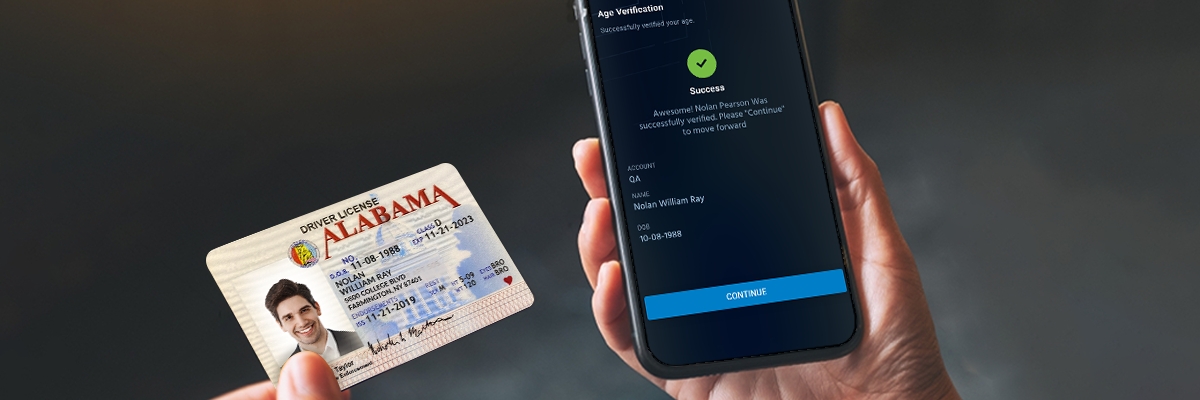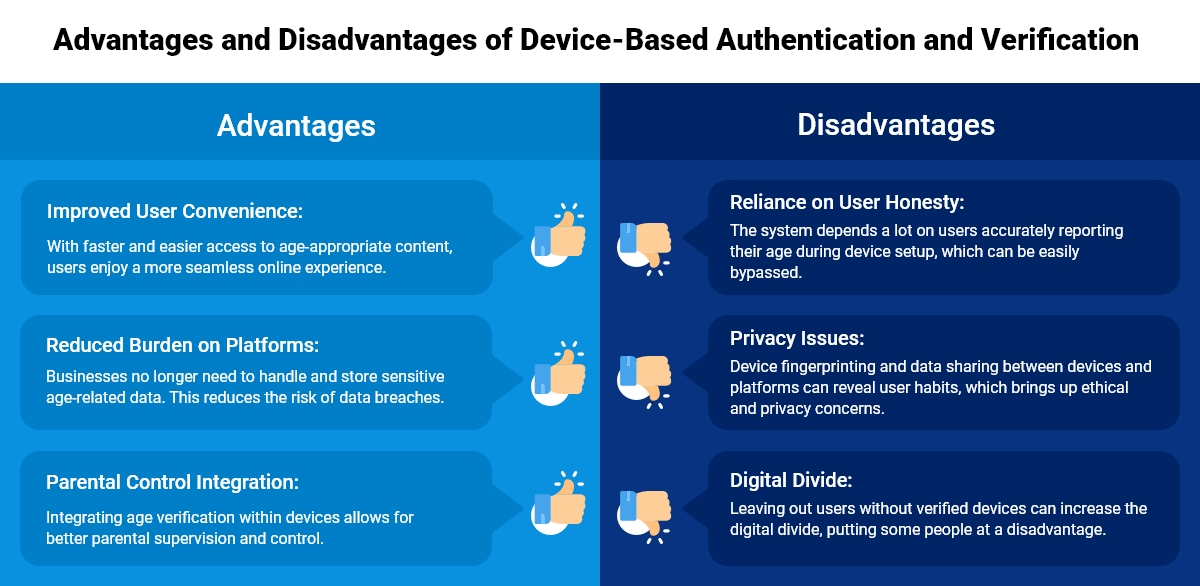The task of verifying someone’s age is a complex but crucial one for many businesses in this digital world we live in. Whether it’s alcohol, vape sales, online gaming, or video streaming, ensuring users meet the minimum age requirement is needed for legal compliance and a safe online environment.
Business owners need effective and scalable age verification systems, and one method is device-based age verification solutions.
This blog post explores what is age verification on device, its benefits, challenges, and how it compares to traditional methods.
What Is Device-Based Age Verification Solutions?
Device-based age verification solutions consist of using information or settings stored on a user’s device to confirm their age. Unlike traditional methods that require government-issued IDs or user-declared ages, this approach depends on the device’s data to make the process easier.
How It Differs from Traditional Methods?
Traditional age verification methods usually require users to provide their birthdate or upload ID documents. Even though they’re effective, these methods can be inconvenient and invasive, often leading to poor user experience.
Device-based verification solutions can significantly improve user age authentication by simplifying the process. This entails eliminating the need for constant re-verification and reducing the collection of sensitive data.
Potential Benefits
The shift to device based verification comes with several benefits, including the following:
Streamlined User Experience: Users can avoid repeated age verification across different platforms, making their online interactions more fluid.
Reduced Reliance on Sensitive Data Collection: By not storing birthdates and other sensitive information, businesses can enhance user privacy with an age verification system.
Scalable Solution for Online Platforms: Device-based verification solutions can easily be scaled across various services, making it ideal for businesses of all sizes.
Next, we will explore the practical steps involved in implementing device-based age verification.
How to Do Device-Based Age Verification?

Carrying out device based verification involves a few important steps, from pre-registration to access control, with some challenges along the way.
Pre-Registration Process
Users are asked to set their age during device setup or app installation. This age information may be linked to parental controls or verified through a trusted third-party service. This first step is important because it lays the foundation for future age checks.
Access Control Mechanisms
Websites or apps can check with the device’s operating system (OS) for verification status once the user’s age is set. Ideally, the OS shares a verification token without revealing the user’s actual birthdate. This means maintaining privacy while ensuring compliance with age restrictions.
Potential Challenges
Despite its promising aspects, age verification on devices does have its challenges.
Accuracy of User-Reported Age: Users may not always report their age accurately during the device setup, which could lead to potential compliance issues.
Lack of Standardization: Different operating systems may handle age verification differently, resulting in complicated implementation across various devices.
Privacy Concerns: Sharing data between devices and platforms raises potential privacy issues that need careful management to guarantee the trust of users.
Advantages and Disadvantages of Device-Based Authentication and Verification

Every technology has its pros and cons, and device-based age verification solutions are no exception.
Advantages:
1. Enhanced Security: Device based verification ensures that only authorized devices can access sensitive information. It reduces the chances of unauthorized access since the verification process is tied to a specific physical device (e.g., a smartphone or laptop).
2. Convenience for Users: It simplifies the authentication process for users, as they do not need to remember passwords or use additional hardware (e.g., hardware tokens). The device itself acts as a trusted factor for verification, making login faster and more seamless.
3. Reduced Risk of Phishing and Credential Theft: Since the authentication is tied to a physical device, it is more challenging for attackers to steal login credentials or perform phishing attacks. The attacker would need physical access to the specific device to bypass the authentication, which is typically more difficult than stealing passwords.
Disadvantages:
1. Device Dependency: If the user loses or forgets the device used for verification, they may be locked out of their account or system. This could be problematic if the user doesn’t have a backup method for recovery, such as a secondary authentication factor or backup code.
2. Privacy Concerns: ID verification devices often require tracking or storing information about the user’s device, which could raise privacy concerns. Some users may not feel comfortable having their device linked to their identity or actions, especially with increased surveillance or data breaches.
3. Vulnerability to Device Theft or Compromise: If a device is stolen or compromised (e.g., through malware or physical tampering), the security of the authentication system could be at risk. In this case, the attacker could bypass the verification process, especially if the device does not have strong encryption or other protective measures.
Overcome ID authentication challenges with a digital age verification solution!
What’s the Current State of Device-Based Age Verification System?
Age verification on devices is still in its early stages, with few real-world applications. Important technical and regulatory challenges remain.
Limited Real-World Implementation
Currently, device-based age verification systems have seen limited adoption due to technical and regulatory challenges. Despite this, though, technology is continuously evolving, and several pilot projects are already exploring its potential.
Ongoing Debate
There is an ongoing debate about the effectiveness of device-based age verification technology and the associated privacy risks. Some experts praise its potential to enhance user convenience and security, while others warn about privacy risks from widespread data sharing.
Focus on Parental Controls
Most current implementations integrate id verification devices with parental control features and content filtering systems. This helps protect minors online, but broader applications are still being developed.
Moving forward, the future of device-based verification solutions looks promising due to the efforts of various stakeholders.
The Future of Device-Based Verification

For device-based verification solutions to become common, device makers, online platforms, and regulators need to work together.
Potential Collaborations
Companies could work together to develop secure, privacy-preserving verification methods.
This could involve leveraging advanced encryption technologies and decentralized verification processes, ensuring that user data is protected at all stages. Such collaborations would not only enhance security but also ensure that the age verification technology benefits both users and businesses by providing a seamless and trustworthy verification experience.
Balanced Approach
The future will likely involve balancing user convenience with responsible online experiences. This means creating age verification systems that are easy to use but strong enough to prevent misuse.
Effective ID verification can allow access to appropriate content while protecting vulnerable users from harmful material, ensuring that online platforms remain safe and trustworthy for all age groups.
Continuous improvements and updates to age verification systems will be crucial to maintain this balance as technology and user expectations evolve.
Use Cases
Consider uses like ID checks for online vape and alcohol sales. These industries need strict age verification to comply with laws, making them perfect for device-based methods. Additionally, these systems could be used for online gambling, mature content, or buying certain medications.
An Alternative Approach: Online ID Verification
While device-based verification solutions hold promise, other methods, like online ID verification, remain crucial.
For example: FTx Identity provides a strong alternative by offering a more comprehensive age verification technology.
Comparing Device-Based Verification to FTx Identity
Reliability: FTx Identity uses official government-issued IDs for verification, reducing the risk of fraud compared to device-based methods.
Check Out How Simple Age Verification Can Be!
Security: By storing consumer information in a cloud-based, secure digital vault, we ensure data security and confidentiality. The data is encrypted and only accessible to the end user.
Compliance: FTx Identity meets strict regulatory requirements, providing peace of mind for businesses.
Until device-based verification solutions is fully reliable, online ID verification, including solutions like FTx Identity, remains the most secure and compliant method for verifying user age.
Wrapping Up
Age verification on device offers a promising alternative to traditional methods but comes with significant challenges. Implementing this technology requires careful consideration of privacy, accuracy, and ethical concerns. While device-based verification methods have potential, online ID verification remains the most reliable and immediate solution for businesses.
For business owners looking to implement an effective age verification system, it’s crucial to stay informed about new technologies and regulatory changes. This ensures your platform provides a safe and compliant environment for all users.



